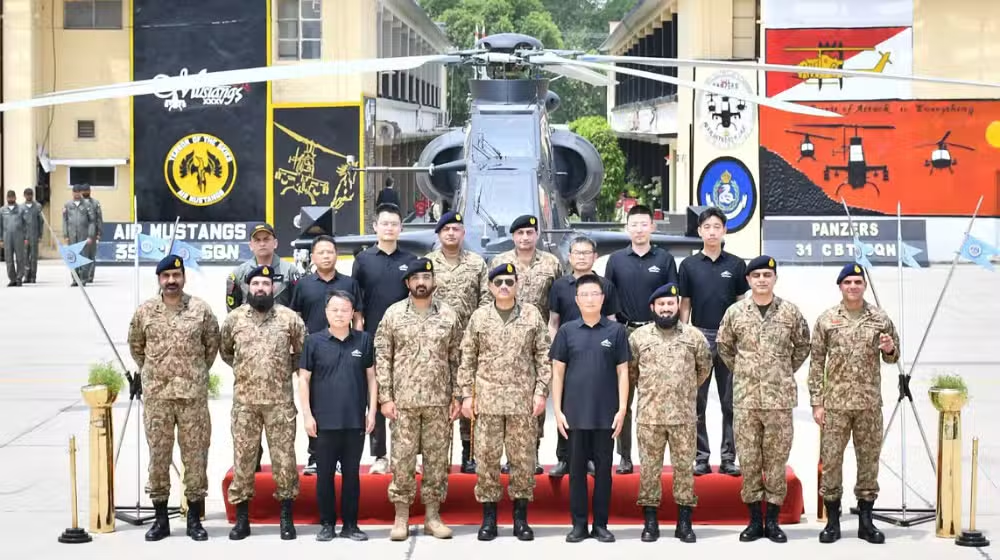Pakistan Army Inducts Z-10ME Attack Helicopter

In a landmark moment for Pakistan’s defense modernization, the Chief of Army Staff (COAS) officially oversaw the induction of the Z-10ME attack helicopter into the Pakistan Army Aviation Corps. This strategic addition represents a significant leap in the country’s aerial strike capabilities, promising enhanced battlefield performance and rapid response power.
The induction ceremony, held at the Muzaffargarh Field Firing Ranges, was followed by a live firepower demonstration showcasing the helicopter’s formidable abilities. From its precision strike capabilities to next-generation avionics, the Z-10ME is set to redefine the operational edge of the Pakistan Army in modern warfare.
Z-10ME: A New Era in Aerial Warfare
The Z-10ME, developed by China’s Changhe Aircraft Industries Corporation, is a modern, all-weather attack helicopter engineered for day and night operations. Designed to perform precision strike missions, it can take on both ground-based and aerial threats with pinpoint accuracy.
Equipped with:
-
🔥 Advanced radar systems
-
🛡 Electronic warfare (EW) suites
-
🎯 Target-tracking and night vision systems
-
🚀 Air-to-ground and air-to-air missile capability
…the Z-10ME is more than just an upgrade it’s a battlefield force multiplier.
Live Demonstration of Power and Precision
After the formal induction, attendees witnessed a live fire demonstration by the Z-10ME fleet. The helicopters conducted simulated battlefield scenarios, highlighting their maneuverability, rapid targeting, and weapons accuracy under combat-like conditions.
Observers from the Pakistan Army, defense specialists, and aviation experts praised the helicopter’s agility and firepower, which reflect Pakistan’s growing emphasis on indigenizing high-tech defense platforms and leveraging modern military technologies.
Strategic Importance of Z-10ME for Pakistan
With security threats becoming increasingly asymmetric and hybrid in nature, battlefield mobility and precision have become critical. The Z-10ME directly addresses these needs by providing:
-
🕹 High-precision missile strikes on enemy tanks, vehicles, and fortifications
-
🌒 Night-time operational capability with thermal and infrared optics
-
📡 EW systems to neutralize enemy radar and tracking systems
-
🛩 Close air support (CAS) for ground troops during intense operations
The induction of such a platform is a step toward modern, network-centric warfare, ensuring combat readiness in diverse terrains, including deserts, mountains, and urban areas.
COAS Praises Modernization Efforts
During the event, the COAS emphasized the need for technologically advanced platforms in safeguarding national sovereignty. He applauded the Army Aviation’s efforts to continually modernize and adapt to emerging threats, stating:
“The induction of the Z-10ME reflects our resolve to equip our armed forces with the latest technology and ensure their dominance in the air and on the ground.”
This move aligns with Pakistan’s broader Vision 2030 defense strategy, which aims to enhance indigenous defense production and incorporate cutting-edge systems across all three military branches.
Comparing the Z-10ME to Global Attack Helicopters
Globally, the Z-10ME finds itself in competition with elite platforms such as the:
-
AH-64 Apache (USA)
-
Ka-52 Alligator (Russia)
-
HAL Rudra (India)
While each platform has its strengths, the Z-10ME offers a cost-effective and technologically robust solution, tailored for Asian operational conditions, particularly mountainous terrain like the Himalayas and the Karakoram.
Its composite armor, missile deflection system, and anti-jamming radar give it the edge in hostile environments where GPS and traditional targeting may fail.
A Boost for Army Aviation Wing
The Pakistan Army Aviation Corps, traditionally composed of utility and surveillance helicopters, is rapidly evolving. With the inclusion of combat-specific aircraft like the Z-10ME, the force has significantly upgraded its offensive capabilities.
Previously reliant on the COBRA attack helicopters and Mi-17s, this addition marks a transition toward a high-tech combat-ready fleet capable of rapid strike missions, surveillance, and electronic warfare.
This complements other recent inductions, such as armed drones and surveillance UAVs, reinforcing the Army’s air-ground integration strategy.
Impact on National Security
Given Pakistan’s geopolitical location, where threats range from cross-border skirmishes to internal counterinsurgency, the Z-10ME plays a crucial role in:
-
Responding swiftly to border infiltrations
-
Supporting counter-terrorism operations in rugged terrain
-
Enhancing rapid troop support and rescue missions
Its range, firepower, and electronic countermeasures also ensure Pakistan can safeguard critical national infrastructure, even under electronic attack or satellite disruption.
Looking Ahead: Indigenous Defense Growth
While the Z-10ME is currently an import, its integration lays the groundwork for:
-
🤝 Technology transfer agreements
-
🏭 Local assembly and maintenance programs
-
🎓 Advanced training modules for Pakistani pilots and engineers
This strengthens Pakistan’s long-term goals of self-reliance in defense production, potentially opening up avenues for local innovation and export



